
The matchstick triangle puzzle: Remove 2 matchsticks to leave 6 triangles
In this matchstick triangle puzzle you have to remove 2 matchsticks to reduce number of triangles from 8 to 6. How many ways can you do it? Time 30 mins.
The puzzle
Part I: Remove 2 matchsticks in a figure made up of 8 triangles to leave just 6 equal triangles, clean with no stick overlap and no stick unattached to a shape.

Part II: In how many ways can you do it? How many rotationally unique solutions can you find?
Total Recommended time is 30 minutes.
Enjoy solving the puzzle.
Comments
Well, how would you solve? Would you pick a stick from any part of the figure and proceed further? Or, you would analyze the figure and then only take your first action?
The second is the systematic approach.
Solution to the matchstick triangle puzzle: Remove 2 matchsticks to leave 6 triangles
The puzzle figure is shown again.

Initial analysis
In solving any matchstick puzzle first thing to do is to,
Examine the figure and identify in what ways it differs from the FINAL figure that you have to make after solving the puzzle.
This is the essential first step COMMON to solving any matchstick puzzle.
Technical term used for the solution figure is the END STATE. So you have to do first end state analysis and arrive at any definite CONCLUSIONS that you can make.
First stage of solution to matchstick triangle puzzle: Identify differences between the puzzle figure and the final solution figure
Two attributes that make the starting and the final figure different are the COUNT of MATCHSTICKS and COUNT of TRIANGLES.
Puzzle figure has 16 matchsticks and final solution figure would have 14, less by 2. Also the puzzle figure has 8 triangles whereas the solution figure would have 6, again less by 2.
So you can make your initial conclusion,
In each stick remove, you have to reduce the number of triangles by 1, that is, you have to destroy 1 and only 1 triangle with each stick move.
Explore possibilities by systematic trial and make further conclusions
Why can’t you destroy 2 triangles in 1 stick move?
Yes, you can. But the result will be bad.
If you remove any of the sticks common between two triangles, you would destroy 2 triangles. The following figure shows such a situation.
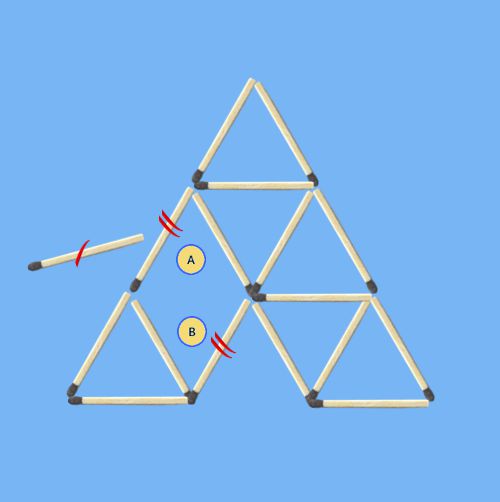
If you remove the single check-marked stick that was common between two triangles A and B, you have surely destroyed the two triangles. But you would also have created two double-check-marked sticks that are not part of any triangle. And you have only one stick removal in your quota left to make these two sticks part of a triangle. An impossible task.
So,
First requirement: You cannot remove any stick that is common between two triangles.
But what about removing any stick and destroying only 1 triangle? That should be a feasible action!
To understand that you cannot just remove any stick that destroys a single triangle, make a small trial by mentally removing any of the corner sticks. The result of such an action is shown.

You have removed the single-check-marked stick of the left corner triangle A. See what happened.
Sure, you have destroyed 1 triangle A by 1 stick removal, but in the process 1 hanging unattached stick is created (double-check-marked). In the second move, if you remove this hanging stick, you would still be short of reducing the number of triangles by 1.
The same would happen if you remove any of the corner sticks of the other two corner triangles B and C.
If you have evaluated and understood these two situations by now, you would be able to refine with confidence the first requirement to a more stringent form,
Second precise requirement: In each of the two stick removes only 1 triangle has to be destroyed creating no hanging stick.
This is the most important requirement of a stick removal that you have specified.
With this precise knowledge, solving the puzzle from this point on would be easy. Search for the 2 sticks to remove would be very focused with this precise property of the sticks to be removed.
Final solution to matchstick triangle puzzle: Finding the two right sticks to remove that satisfy the stringent requirements
With the knowledge gained till now, you would be able to refine the action requirement further to,
Third refined requirement: Each of the stick to be removed must be such that removing it, no part of the rest of the structure is disturbed except reduction of triangles by 1.
You may call this type of stick as a FREE STICK, removal of which does not disturb the rest of the figure except reducing number of triangles by 1.
With the awareness of what to look for, it does not take much time to identify two sticks each of which satisfies the specific requirements. This gives you the solution, as shown in the figure.

This is your first solution. By removing two check-marked sticks you have reduced the number of triangles cleanly to 6 as is required.
But remember, you have solved the first part of your puzzle. Second part still remains to be done.
Solution to Second part of the matchstick triangle puzzle: How many solutions?
Without any hesitation, now you quickly identify two more free sticks, 4 free sticks in all. There is no more free stick meeting our requirement specification in this puzzle figure. The situation is shown.
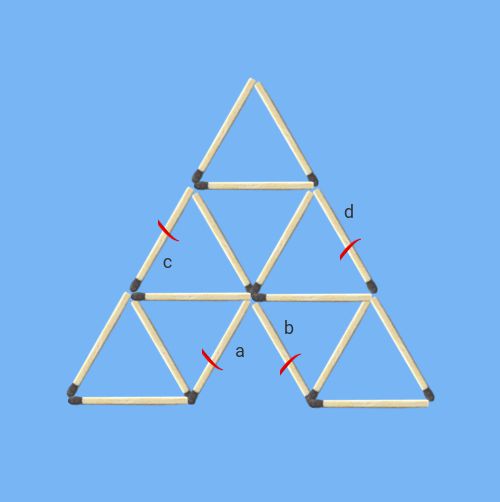
The four check-marked are the four free sticks. You would expect that removing ANY PAIR of sticks from these four would give you a solution.
Well, how many combinations or pairs can there be?
To accurately identify the combinations, the four sticks are further labeled as a, b, c and d as shown.
With this alphabetic labeling help, you can now easily identify all possible distinct pairs that can be chosen from these four free sticks a, b, c and d. The possible pair combinations are,
ab, cd, ac, bd, ad and bc.
In the first solution, the combination ab is already used.
The solution for combination cd is easy to visualize. It must be the second solution.
In whatever way you rotate it, the figure remains different from your first solution. It is the second rotationally unique solution. It is shown.
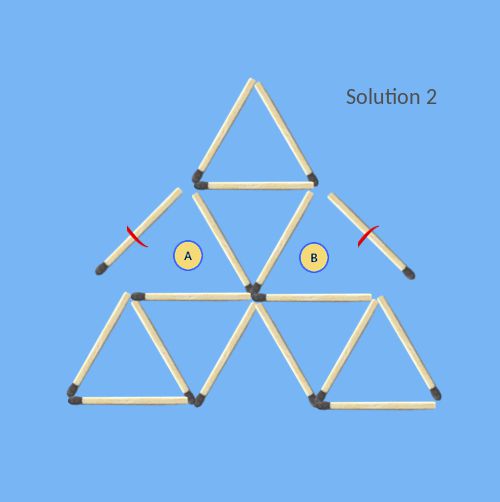
The two single-check-marked sticks are removed reducing number of triangles cleanly by 2. The triangles A and B are destroyed cleanly in this solution.
Any more solutions?
But what happens if you remove first stick a and then stick c? Here, you are examining whether stick combination, ac may produce a unique solution.
The situation is shown.
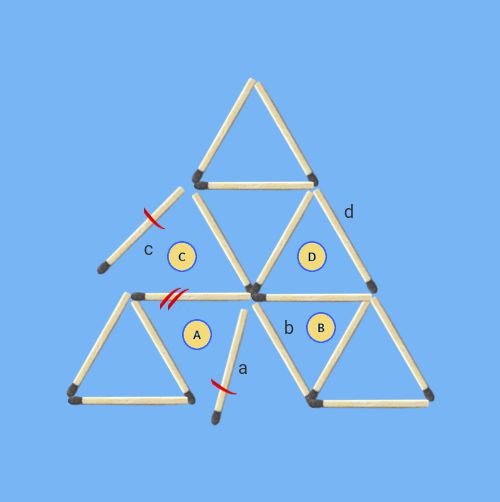
First removal of a satisfies the stringent specification of stick that can be removed, but not the second stick c. The second stick removal creates a double-check-marked hanging stick and results in no solution.
The number of triangles also reduced by 2 (as triangle A and C are destroyed by removal of stick a and stick c), but the single hanging stick made this combination of stick removal invalid.
You may express this situation in a more compact form as,
Fourth conclusion on stick removal constraint: In a valid solution of this puzzle, no two adjacent triangles can be destroyed.
By stick removal combination ac, the triangles destroyed are triangles A and C that are adjacent. So, this combination is not valid.
Apply this more advanced rule and realize that the stick removal combination bd also is invalid as the two triangles B and D destroyed are adjacent.
By the same rule then, both the stick removal combinations ad and bc should result in a valid solution. The two possible solutions are shown below side by side.

Question is—are these two solutions both ROTATIONALLY unique?
Uniqueness of a geometric shape requires,
If the shape is rotated in any way (or flipped horizontally or vertically), it should not become the same as another shape that is already under consideration for uniqueness.
This is the rotationally unique property for the two possible solutions. And if you flip the possible solution 4 horizontally, it would become exactly the same as the possible solution 3. The two possible solutions are not unique—they represent only one unique solution.
The third unique solution is shown.
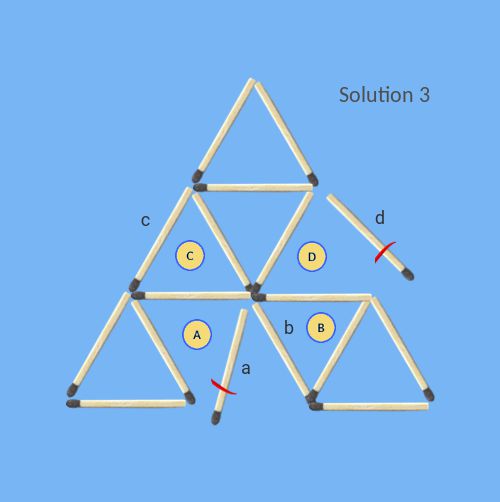
Answering the second part of the puzzle is not as easy as finding the first solution. But once you go through the exhaustive step by step systematic method for finding all unique solutions, you gain an insight in pattern structures and methods that you won’t have had otherwise.
Know how to solve difficult problems easily without wasting time on random attempts
Our ebook on puzzle solutions by innovative methods will show you just that.
Puzzles for Adults: 50 Brain Teasers with Step-by-Step Solutions: Boost Your Power of Problem Solving
BUY the eBook Amazon Kindle version here, from Google Play here and Paperback here.
Second book on Innovative Solutions to Matchstick Puzzles from Suresolv

BUY Creative Matchstick Puzzles Innovative Solutions eBook Amazon Kindle version
BUY the paperback here.
Puzzles you may enjoy
Easy to hard brain teasers with systematic solutions
Challenging brain teasers with solutions: Long list.
This will always be the most up-to-date full list with the brain teasers classified into categories that can be browsed separately.
You may also click on the category term link below to enjoy the brain teasers that are classified in the present category.
For example, if the category term link shown below is "Riddle", click on it to go through all the Riddles.

